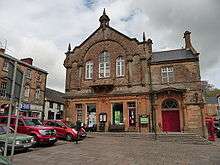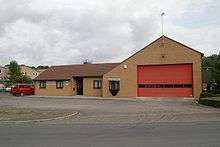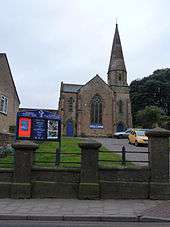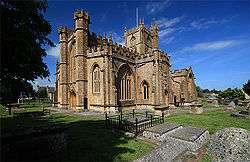Crewkerne
Coordinates: 50°52′49″N 2°47′38″W / 50.8803°N 2.7939°W
Crewkerne /ˈkruːkərn/ is a town and electoral ward in Somerset, England, situated 9 miles (14 km) south west of Yeovil and 7 miles (11 km) east of Chard in the South Somerset district close to the border with Dorset. The civil parish of West Crewkerne includes the hamlets of Woolminstone and Henley. The town lies on the River Parrett, A30 road and West of England Main Line railway.
The earliest written record of Crewkerne is in the 899 will of Alfred the Great. After the Norman conquest it was held by William the Conqueror and in the Domesday Survey of 1086 was described as a royal manor. Crewkerne Castle was possibly a Norman motte castle. The town grew up in the late mediaeval period around the textile industry, its wealth preserved in the fifteenth century Church of St Bartholomew. During the 18th and 19th centuries the main industry was cloth making, including webbing, and sails for the Royal Navy.
Local ecological sites include the Bincombe Beeches Local Nature Reserve and the Millwater biological Site of Special Scientific Interest. Crewkerne railway station is served by South West Trains on the main south western railway line. There are local supermarkets and local shops, and some local industry. The town is the birthplace of several notable people and has varied cultural and sporting facilities including those at Wadham Community School.
History
_-_BL_Stowe_MS_944%2C_f_30v.jpg)
The name Crewkerne is thought to be derived from Cruc-aera; from the British cruc - a spur of a hill, and the Old English aera - a house, especially a storehouse.[3] The town was known as Crocern, or Cruaern in the 899 will of Alfred the Great when he left it to his younger son Æthelweard, and by 1066 the manor was held by Edith Swanneck mistress of King Harold.[4] After the Norman conquest it was held by William the Conqueror and the church estate was given to the Abbaye-aux-Hommes in Caen, Normandy.[4] In the Domesday Survey of 1086 it was described as a royal manor.[5]
In 1499, John de Combe, a precentor of Exeter Cathedral and former vicar of Crewkerne, founded Crewkerne Grammar School. The school survived until 1904.[6]
The parish was part of the hundred of Crewkerne.[7]
Crewkerne Castle was possibly a Norman motte castle on a mound to the north-west of the town, which is known as Castle Hill.[8] The town grew up in the late mediaeval period around the textile industry,[9] its wealth preserved in its fifteenth century parish church. It later prospered as a coaching stop in the Georgian period.[9]
The Manor Farmhouse in Henley was built from hamstone in the early 17th century, but possibly incorporates medieval fragments. The building is designated by English Heritage as a Grade II* listed building.[10] During the 18th and 19th centuries the main industry was cloth making, including webbing,[9] and sails for the Royal Navy.[11]
Governance

The town council has responsibility for local issues, including setting an annual precept (local rate) to cover the council’s operating costs and producing annual accounts for public scrutiny. The parish council evaluates local planning applications and works with the local police, district council officers, and neighbourhood watch groups on matters of crime, security, and traffic. The parish council's role also includes initiating projects for the maintenance and repair of parish facilities, as well as consulting with the district council on the maintenance, repair, and improvement of highways, drainage, footpaths, public transport, and street cleaning. Conservation matters (including trees and listed buildings) and environmental issues are also the responsibility of the council.
The town falls within the non-metropolitan district of South Somerset, which was formed on 1 April 1974 under the Local Government Act 1972, having previously been Crewkerne Urban District.[12] The district council is responsible for local planning and building control, local roads, council housing, environmental health, markets and fairs, refuse collection and recycling, cemeteries and crematoria, leisure services, parks, and tourism. This electoral ward includes Misterton and at the 2011 Census had a population of 7,826.[13]
The Town Hall occupies the lower part of the Victoria Hall in the Market Square. The Hamstone building was rebuilt around 1742, altered in 1836, when a south piazza was added after the demolition of the shambles. In 1848-9 it became a museum, reading room and library and was remodelled in 1900 by Thomas Benson of Yeovil to create shops and offices. It is a Grade II listed building.[14]

Somerset County Council is responsible for running the largest and most expensive local services such as education, social services, the library, roads, public transport, trading standards, waste disposal and strategic planning, although fire, police and ambulance services are provided jointly with other authorities through the Devon and Somerset Fire and Rescue Service, Avon and Somerset Constabulary and the South Western Ambulance Service.
It is also part of the Yeovil county constituency represented in the House of Commons of the Parliament of the United Kingdom. It elects one Member of Parliament (MP) by the first past the post system of election, and part of the South West England constituency of the European Parliament which elects six MEPs using the d'Hondt method of party-list proportional representation.
Geography

The town lies west of the River Parrett. The main residential areas are around the town centre with Kithill and Park View to the South and Wadham Park to the North.
In the northern outskirts of the town is the Bincombe Beeches 5 hectares (12 acres) Local Nature Reserve.[15] which is managed by the town council and includes a line of beech trees, some of which are between 150 and 200 years old.[16] Between 2002 and 2005 grants were obtained to improve access to the site and support the planting of new trees.[17] The Millwater biological Site of Special Scientific Interest consists of a complex mosaic of pasture, wet grassland, tall-herb fen, standing and running water, Alder and Willow carr.[18]
Climate
Along with the rest of South West England, Crewkerne has a temperate climate which is generally wetter and milder than the rest of the country.[19] The annual mean temperature is approximately 10 °C (50.0 °F). Seasonal temperature variation is less extreme than most of the United Kingdom because of the adjacent sea temperatures. The summer months of July and August are the warmest with mean daily maxima of approximately 21 °C (69.8 °F). In winter mean minimum temperatures of 1 °C (33.8 °F) or 2 °C (35.6 °F) are common.[19] In the summer the Azores high pressure affects the south-west of England, however convective cloud sometimes forms inland, reducing the number of hours of sunshine. Annual sunshine rates are slightly less than the regional average of 1,600 hours.[19] In December 1998 there were 20 days without sun recorded at Yeovilton. Most the rainfall in the south-west is caused by Atlantic depressions or by convection. Most of the rainfall in autumn and winter is caused by the Atlantic depressions, which is when they are most active. In summer, a large proportion of the rainfall is caused by sun heating the ground leading to convection and to showers and thunderstorms. Average rainfall is around 700 mm (28 in). About 8–15 days of snowfall is typical. November to March have the highest mean wind speeds, and June to August have the lightest winds. The predominant wind direction is from the south-west.[19]
Transport
The following major roads pass through Crewkerne:
- Northbound: A356 North Street — To A303 for London and North Somerset.
- Southbound: A356 South Street- To Maiden Newton and Dorchester.
- Westbound: A30 West Street — To Exeter and the South West of England.
- Eastbound :A30 East Street — To Yeovil and Salisbury.
- Southbound: B3156 Hermitage Street — To Lyme Regis.

Crewkerne railway station is served by South West Trains on the main south western railway line. Trains operate to London Waterloo (two and a half hours away) via Salisbury (70 minutes), and in the opposite direction to Exeter St Davids (under an hour).[20] The station was opened by the London and South Western Railway on 19 July 1860.[21] It was designed by Sir William Tite and has been designated as a Grade II listed building.[22]
The town is served by Stagecoach South West with buses to Yeovil via Kithill, Misterton and Haselbury Plucknett and Chard. Buses also run to Merriott, South Petherton and Ilminster and Taunton. First Somerset & Avon has service to Bridport via Beaminster and Broadwindsor, Yeovil via East Chinnock and West Coker and Chard.[23]
It is on the route of the Monarch's Way a 615-mile (990 km)[24] long-distance footpath in England that approximates the escape route taken by King Charles II in 1651 after being defeated in the Battle of Worcester.[25]
Economy

Crewkerne is a small market town centre with many cafes, shops and supermarkets. Crewkerne also has a wide selection of public houses. The largest supermarket is the Waitrose store which is around 21,000 sq ft (2,000 m2) and opened in November 2008.[26] All of the large supermarkets are situated around the South Street multi-storey car park. The other smaller supermarkets are Co-operative (previously Somerfield) and Lidl.
Ariel Motor Company is based in Crewkerne, and is one of the UK's smallest automobile companies, with just seven employees, producing fewer than 100 cars per year. It was founded in 1991 and changed its name from Solocrest Ltd in 2001. The company's flagship car is the Ariel Atom, an extremely light, high performance car.[27]
Religious sites

St Bartholomew's Parish Church stands on high ground to the west of the town. The first Saxon church was founded before the end of the 9th century as a "minster", or main church of a Saxon royal estate that included an area which later became the parishes of Seaborough, Wayford and Misterton. This church was replaced after the Norman Conquest with a larger stone cruciform building, with a central tower. This was almost completely rebuilt and enlarged in the late 15th and early 16th centuries. This is, for the most part, the church building visible today. It is an excellent example of the Perpendicular style with many unusual and individual features. These include the west front, the nave, the six-light aisle windows and the Tudor-style chapels and windows in the north east corner. The building material is golden-coloured Ham Hill stone, quarried nearby. There is a notable pair of 'green man' carvings within the church.
No major alterations have been made since the Reformation in the 1530s and 1540s, but there have been many changes to the interior to accommodate various phases of Church of England worship. Among these are an oven used for baking communion bread in the south east corner of the north chapel.[11] During the Civil War, considerable damage was done including the destruction of nearly all of the medieval stained glass. William III of England worshipped in the church following his landing in the Glorious Revolution of 1689.[11] By the early 19th century, all the medieval furnishings, except the Norman font had disappeared. New pews were made and the west galleries were added in 1808-11. The latest restoration that has left the church interior visible today, took place in the late 19th century; it was more sympathetic to the church's architectural character than many Victorian restorations. At this time, the central section of the west gallery was removed to reveal the great west window and the organ was relocated to the south transept. The pews date from around 1900 and have attractive carved bench-ends. The church has been designated by English Heritage as a Grade I listed building.[28]
Crewkerne also contains one of very few Unitarian chapels left in the West Country, Crewkerne Unitarian Church, a tiny chapel tucked away on Hermitage Street.[29] The Methodist church on South Street is shared by Roman Catholic and Methodist congregations, following the closure and proposed redevelopment of St Peter's Catholic Church.
Education
The two primary schools within Crewkerne are St. Bartholomew's first school which is located on Kithill and Ashlands which is located in North Street. The middle school is called Maiden Beech Middle School which is located on the B3165 Lyme Road. The school has students from ages 9 to 13 and this is where they do their Key Stage 2 SATS.
Crewkerne Grammar School was situated at DeCombe House, until it closed in the late 1960s, before the Grammar school was combined into St Martins School of Abbey Street. St Martins used to be situated in the High Street, until it moved to its current position in the late 1970s. The Senior and Juniors School section closed in 2003, and now serves as a pre-school nursery only. The School Gymnasium was located along Gouldsbrook Terrace, and is still undergoing repairs to the floor and roof.
Wadham School has students from 13 to 18 years old and includes those travelling from surrounding villages. In November 2005, Wadham was placed into Special measures after failing an Ofsted inspection. In June 2007 Wadham successfully left Special Measures, after a full Ofsted inspection showed the school had sufficiently progressed.[30]
Culture
The Henhayes Centre provides conference facilities and has also featured exhibitions.[31]
Crewkerne and District Museum is part of a wider heritage centre which includes local archives and a meeting room.[32] The museum opened in 2000 in an old house with an 18th-century frontage. It was restored with the help of grants from the Heritage Lottery Fund, Somerset County Council, South Somerset District Council and Crewkerne Town Council.[32] The development of Crewkerne during the 18th and 19th centuries, with particular emphasis on the flax and linen industry is illustrated with a permanent display.[33] Other collections relate to local archaeology, Coins and Medals, Costume and Textiles, Fine Art, Music, Personalities, Science and Technology, Social History, Weapons and War.[34]
Sport
The Crewkerne Aqua Centre also provides swimming pool and fitness gym facilities to the town, located on the grounds next to Henhayes Park, which used to be the Grammar Schools Playing fields.[35] St. Martins School retained the use of the playing fields until the junior section was closed in 2003, as regular sports days were a tradition dating back to the Grammar school era in the town. A further sports centre is situated on the Wadham School campus.[36] Crewkerne Cricket Club play in the Dorset Funeral Plan Cricket League,[37] whilst Both Crewkerne Town F.C. and Crewkerne Rangers F.C. play in the Perry Street and District League.[38]
Notable residents
Thomas Coryat a traveller and writer of the late Elizabethan and early Jacobean age was born in Crewkerne around 1577.[11] Mathematician John Caswell was also born here. A later traveller Colonel Joshua Fry was born in the town in 1699 before becoming a surveyor, adventurer, mapmaker, soldier, and member of the House of Burgesses, the legislature of the colony of Virginia.[39] Another Englishman from Crewkerne who emigrated to the American Colonies was William Phelps who was born around 1599 and became one of the founders of both Dorchester, Massachusetts and Windsor, Connecticut, foreman of the first grand jury in New England, served most of his life in early colonial government, and played a key role in establishing the first democratic town government in the American colonies.[40] Ralph Reader CBE an actor, theatrical producer and songwriter, best known for staging the original Gang Show, a Variety show for members of the Scouting Movement, was born in Crewkerne in 1903.[41] The cricketer Michael Barnwell was born in the town in 1943.[42]
Twin towns
Crewkerne is twinned with Igny, Essonne and Bures-sur-Yvette in France.[43]
References
- ↑ "Statistics for Wards, LSOAs and Parishes — SUMMARY Profiles" (Excel). Somerset Intelligence. Retrieved 4 January 2014.
- ↑ Charter S 1507 at the Electronic Sawyer
- ↑ Havinden, Michael. The Somerset Landscape. The making of the English landscape. London: Hodder and Stoughton. p. 84. ISBN 0-340-20116-9.
- 1 2 Richardson, Miranda. "Crewkerne" (PDF). Somerset Extensive Urban Survey. Somerset County Council. Archived from the original (PDF) on 17 July 2011. Retrieved 22 May 2010.
- ↑ "Crewkerne". National Gazetteer (1868). GenUKI. Retrieved 22 May 2010.
- ↑ "Crewkerne Grammar School". The National Archives. Government of the United Kingdom. Retrieved 2012-03-08.
- ↑ "Somerset Hundreds". GENUKI. Retrieved 8 October 2011.
- ↑ Fry, Plantagenet Somerset, The David & Charles Book of Castles, David & Charles, 1980. ISBN 0-7153-7976-3
- 1 2 3 Dunning, Robert (1980). Somerset and Avon. Edinburgh: John Bartholomew and Son. p. 70. ISBN 0-7028-8380-8.
- ↑ "Henley Manor Farmhouse". Images of England. Retrieved 2 February 2008.
- 1 2 3 4 Leete-Hodge, Lornie (1985). Curiosities of Somerset. Bodmin: Bossiney Books. p. 96. ISBN 0-906456-98-3.
- ↑ "Crewkerne UD". A vision of Britain Through Time. University of Portsmouth. Retrieved 4 January 2014.
- ↑ "Ward population 2011". Retrieved 21 October 2015.
- ↑ "Victoria Hall". Images of England. English Heritage. Retrieved 22 May 2010.
- ↑ "Bincombe Beeches". Natural England. Retrieved 22 May 2010.
- ↑ "Bincombe Leaflet" (PDF). Crewkerne Town Council. Retrieved 22 May 2010.
- ↑ "Bincombe Beeches Local Nature Reserve". Natural England. Retrieved 22 May 2010.
- ↑ "Millwater" (PDF). English Nature. Archived from the original (PDF) on 13 October 2006. Retrieved 9 September 2006.
- 1 2 3 4 "South West England: climate". Met Office. Archived from the original on 5 June 2011. Retrieved 14 March 2010.
- ↑ "Table 160: London to Salisbury and Exeter" (PDF). Electronic National Rail Timetable. Network Rail. May 2010. Retrieved 24 August 2010.
- ↑ Phillips, Derek; Pryer, George (1997). The Salisbury to Exeter Line. Sparkford: Oxford Publishing Company. pp. 98–101. ISBN 0-86093-525-6.
- ↑ "Crewkerne Railway Station". Images of England. English Heritage. Retrieved 30 January 2009.
- ↑ "Information about bus, coach and train services from, and other local services in, Crewkerne.". Travel Search. Carlberry. Retrieved 23 May 2010.
- ↑ "The Monarch's Way". The Monarch's Way Association. Retrieved 2 February 2006.
- ↑ "The Monarch's Way". The Quinton Oracle. 2005. Retrieved 30 August 2008.
- ↑ "Crewkerne gives Waitrose the thumbs up". Yeovil Express. 7 January 2008. Retrieved 23 May 2010.
- ↑ "Ariel Motor Co". Ariel Motor Co. Archived from the original on 30 March 2010. Retrieved 23 May 2010.
- ↑ "Church of St Bartholomew". Images of England. Retrieved 6 October 2007.
- ↑ "West Unitarians". Western Unitarians Congregations. Retrieved 12 November 2009.
- ↑ "School is out of special measures". Smallholder. Retrieved 2008-10-06.
- ↑ "Henhayes Centre". Henhayes Centre. Retrieved 22 May 2010.
- 1 2 "Crewkerne Heritage Centre". Communigate. Retrieved 27 May 2010.
- ↑ "Crewkerne Heritage Centre". South Somerset Council. Retrieved 21 August 2010.
- ↑ "Crewkerne Museum". Culture 24. Retrieved 27 May 2010.
- ↑ "Crewkerne Aqua Centre". Crewkerne Aqua Centre. Retrieved 23 May 2010.
- ↑ "Crewkerne Sports Centre". Somerset County Council. Retrieved 23 May 2010.
- ↑ "Crewkerne Cricket Club". Crewkerne Cricket Club. Retrieved 22 May 2010.
- ↑ "Perry Street & District League". TheFA.com. Retrieved 8 May 2012.
- ↑ Stannard, W.G. (1894). "Virginians at Oxford". The William and Mary Quarterly. 2 (3): 149–153. doi:10.2307/1915310. JSTOR 1915310. (subscription required (help)).
- ↑ "First generation of Phelps in Windsor, Connecticut". Phelps Family History. Retrieved 25 August 2010.
- ↑ "Ralph Reader CBE". Hinkley Gang Show. Retrieved 23 May 2010.
- ↑ "Mike Barnwell". CricInfo. Retrieved 13 June 2010.
- ↑ "Crewkerne – Banking Court Neighbourhood Plan" (PDF). Yarlington Housing Group. Retrieved 6 June 2012.
External links
| Wikimedia Commons has media related to Crewkerne. |



